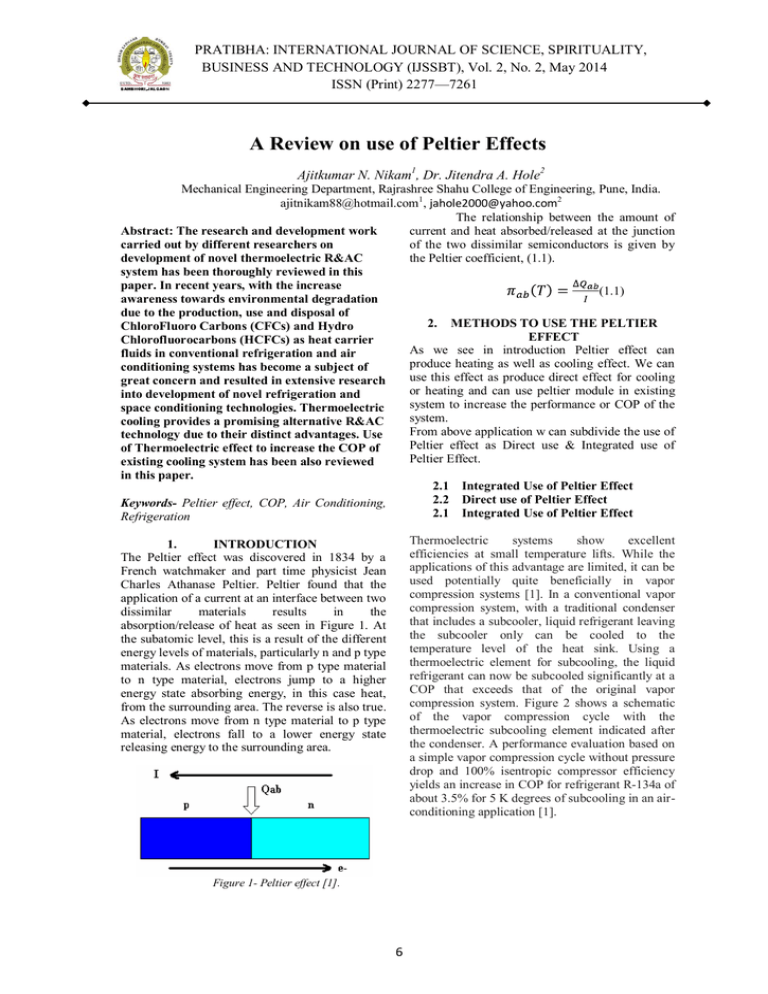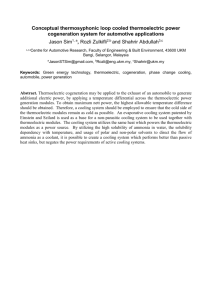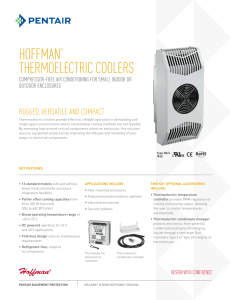A Review on use of Peltier Effects - International Journal of Science
advertisement

PRATIBHA: INTERNATIONAL JOURNAL OF SCIENCE, SPIRITUALITY, BUSINESS AND TECHNOLOGY (IJSSBT), Vol. 2, No. 2, May 2014 ISSN (Print) 2277—7261 A Review on use of Peltier Effects Ajitkumar N. Nikam1, Dr. Jitendra A. Hole2 Mechanical Engineering Department, Rajrashree Shahu College of Engineering, Pune, India. ajitnikam88@hotmail.com1, jahole2000@yahoo.com2 The relationship between the amount of current and heat absorbed/released at the junction Abstract: The research and development work of the two dissimilar semiconductors is given by carried out by different researchers on the Peltier coefficient, (1.1). development of novel thermoelectric R&AC system has been thoroughly reviewed in this paper. In recent years, with the increase (1.1) awareness towards environmental degradation due to the production, use and disposal of 2. METHODS TO USE THE PELTIER ChloroFluoro Carbons (CFCs) and Hydro EFFECT Chlorofluorocarbons (HCFCs) as heat carrier As we see in introduction Peltier effect can fluids in conventional refrigeration and air produce heating as well as cooling effect. We can conditioning systems has become a subject of use this effect as produce direct effect for cooling great concern and resulted in extensive research or heating and can use peltier module in existing into development of novel refrigeration and system to increase the performance or COP of the space conditioning technologies. Thermoelectric system. cooling provides a promising alternative R&AC From above application w can subdivide the use of technology due to their distinct advantages. Use Peltier effect as Direct use & Integrated use of of Thermoelectric effect to increase the COP of Peltier Effect. existing cooling system has been also reviewed in this paper. 2.1 Integrated Use of Peltier Effect 2.2 Direct use of Peltier Effect Keywords- Peltier effect, COP, Air Conditioning, 2.1 Integrated Use of Peltier Effect Refrigeration Thermoelectric systems show excellent efficiencies at small temperature lifts. While the applications of this advantage are limited, it can be used potentially quite beneficially in vapor compression systems [1]. In a conventional vapor compression system, with a traditional condenser that includes a subcooler, liquid refrigerant leaving the subcooler only can be cooled to the temperature level of the heat sink. Using a thermoelectric element for subcooling, the liquid refrigerant can now be subcooled significantly at a COP that exceeds that of the original vapor compression system. Figure 2 shows a schematic of the vapor compression cycle with the thermoelectric subcooling element indicated after the condenser. A performance evaluation based on a simple vapor compression cycle without pressure drop and 100% isentropic compressor efficiency yields an increase in COP for refrigerant R-134a of about 3.5% for 5 K degrees of subcooling in an airconditioning application [1]. 1. INTRODUCTION The Peltier effect was discovered in 1834 by a French watchmaker and part time physicist Jean Charles Athanase Peltier. Peltier found that the application of a current at an interface between two dissimilar materials results in the absorption/release of heat as seen in Figure 1. At the subatomic level, this is a result of the different energy levels of materials, particularly n and p type materials. As electrons move from p type material to n type material, electrons jump to a higher energy state absorbing energy, in this case heat, from the surrounding area. The reverse is also true. As electrons move from n type material to p type material, electrons fall to a lower energy state releasing energy to the surrounding area. Figure 1- Peltier effect [1]. 6 PRATIBHA: INTERNATIONAL JOURNAL OF SCIENCE, SPIRITUALITY, BUSINESS AND TECHNOLOGY (IJSSBT), Vol. 2, No. 2, May 2014 ISSN (Print) 2277—7261 Figure 2- Schematic of vapor compression cycle with TE subcooler [1]. Figure 3- Performance enhancement with subcooling [1] As result comes, from COP peaks according to Figure 3a at 15 K degrees of subcooling at about 20% capacity increase according to Figure 3b, the capacity keeps increasing to about 40% at 35 K degrees of subcooling [1]. Peltier effect also used in application of thermoelectric devices to enhance the performance of air-cooled heat exchanger [2]. Thermoelectric devices are capable of converting electrical energy into thermal heat-pumping at a very high efficiency [2]. In this application TE device in a part of a coil to investigate the improvement potential. A schematic of a TE enhanced air-cooled heat exchanger is shown in Figure 4. A half cross section of a tube-fin heat exchanger is shown in Figure 4 along with a TE element placed between the fins and the tube. The power supply connections for the TE element are not shown for simplicity. From Figure 5 it can be seen that with relatively low power consumption the TE element is able to provide temperature lifts of more than 10K. Comparing the heat transferred per fin with the power consumption, it is possible to calculate a coefficient of performance for the TE device. From Figures 5a and 5b, an optimal value of temperature lift can be chosen for a given application. Figure 5- Simulation results - effect of TE device power consumption [2]. The experiments show that when a TE device is used as a dedicated subcooler at the condenser outlet, a 16.2% increase in system COP and over 20% increase in cooling capacity can be achieved. This also means when designing a system for a given capacity and application, it is possible to significantly reduce the heat exchanger sizes thereby reducing the cost of the system [2]. Figure 4- Schematic of a TE enhanced tube-fin heat exchanger [2]. 7 PRATIBHA: INTERNATIONAL JOURNAL OF SCIENCE, SPIRITUALITY, BUSINESS AND TECHNOLOGY (IJSSBT), Vol. 2, No. 2, May 2014 ISSN (Print) 2277—7261 Thermoelectric (TE) modules have been integrated into a subcooler of an experimental CO2 transcritical vapor compression cycle test system [3].The TE Subcooler was designed and fabricated to subcool CO2 exiting the gas cooler to a temperature below ambient. The heat from the TE Subcooler was rejected to the ambient utilizing a separate thermosyphon refrigerant loop with a separate condenser. The thermoelectric modules operate at efficiencies greater than the baseline system, increasing capacity and the overall coefficient of performance (COP) of the entire system. Figure 6 shows the A small CO2 transcritical vapor compression cycle was built to test the potential performance improvement of a TE Subcooler utilizing a prototype compressor with a cooling capacity of roughly 1 kW. Figure 6 - Schematic of the experimental setup [3]. The TE Subcooler was aligned vertically, with setup the thermosyphon condenser was integrated CO2 entering at the top from the gas cooler and into the gas cooler utilizing the same set of fans. exiting at the bottom to the expansion valve. The Initial testing showed that this significantly thermosyphon refrigerant, in this case R22, boils reduced the capacity of the gas cooler and resulted within the heat rejection microchannels. The vapor in a negligible system performance improvement. refrigerant travels upward to the thermosyphon In subsequent testing the thermosyphon condenser condenser, where it condenses and travels back to was separated from the gas cooler employing a the inlet of the heat rejection microchannels at the second fan. For above experimental setup a listed bottom of the TE Subcooler. In the original system system performance as shown in below table no. 1 Baseline System TE System TE System System (Maximum COP) (Maximum COP) (Maximum Capacity) System COP 2.354 2.476 (+5.2%) 2.379 (+1.1%) System Capacity (kW) 1.44 1.569 (+9.2%) 1.657 (+15.3%) Discharge Pressure (kPa) 9553 9042 9206 Compressor Power (kW) 0.61 0.591 0.601 Mass Flow Rate (g/s) 9.9 10.2 10.1 TE Supply Current (Amps) 4 6 Number of Modules 10 10 TE Capacity (kW) 0.204 0.256 TE COP 4.839 2.676 GC/TE Outlet Temperature (°C) 36.6 33.9 31.9 Table 1- Baseline and TE Subcooler system performance at a suction pressure of 4,198 kPa [3]. Performance improvement of a CO2 transcritical cycle utilizing a TE Subcooler was experimentally demonstrated. An increase in COP of 5% was achieved with a corresponding 9% increase in capacity. A capacity improvement of 15% was achieved at comparable COP as the baseline system [3]. 2.2 Direct use of Peltier Effect Refrigeration effect can be produce by direct use of Peltier Modules [5]. To obtain such effects thermoelectric refrigerator with an inner volume of 55 X 103 m3 has been designed and tested, whose cold system is composed of a Peltier pellet (50 W of maximum power) and a fan of 2 W. An 8 PRATIBHA: INTERNATIONAL JOURNAL OF SCIENCE, SPIRITUALITY, BUSINESS AND TECHNOLOGY (IJSSBT), Vol. 2, No. 2, May 2014 ISSN (Print) 2277—7261 experimental analysis of its performance in different conditions has been carried out [5].A thermal scheme of the thermoelectric refrigerator and a photograph of the prototype are respectively shown in Figs. 7 and 8. The Peltier pellet is supplied with a continuous current (Vmax = 12 V) so that heat is liberated by one side and absorbed by the other one. The firstlaw of thermodynamics for steady state (expressed by powers) applied to a refrigerating machine, is the following: The main disadvantage is linked to the electricity consumption. The electric energy consumed by a thermoelectric refrigerator is higher in comparison with current compression refrigerators (approximately the same as a vapour compression one with an inner volume of 100 X 103 m3). Peltier effect also has been used directly to produce the refrigeration Effect [6]. This can be experimentally shown by creating the setup as shown in fig. 9. The main body of the refrigeration chamber has a dimension of: 0.11x0.29x0.33 m³ strongly insulated to minimize heat loss to the ambient air. In the cross section of this chamber, three layers exist: two walls of aluminum separated by an insulating material of 3 cm of thickness. Refer to figure 9 . Figure 9- Main body of the refrigeration chamber [6]. Figure 8- Photograph of the thermoelectric refrigerator [5] High density heat sinks were specially fabricated for this project. They are made of Aluminum and are 350 x 75 x 39 mm³, with 21 fins along their length and weight is 1500 Grams. Their specific heat is 0.963 J/g.°C. The ―hot‖ surface of the thermoelectric heat pump must be attached to a heat sink that is a capable of carrying away both the heat pumped by the modules and the heat generated by the Joule effect [6]. The ―cold‖ surface is also attached to another heat sink that will carry away the cold air, hence decreasing the temperature differential _T, and then making the thermoelectric more efficient. A ―spacer block‖ is also put between the modules and the heat sinks. Its thickness, of 18 mm, separates the ―hot‖ heat sink from the ―cold‖ one, which yields to a maximum heat transfer. The refrigeration chamber was run for many values of input current. The temperature, time and input electrical power were measured. The obtained COP for the different current is shown in table 2. Figure 7- Thermal sketch of the thermoelectric refrigerator [5]. For instance: lower level of noise and vibrations, a greater useful life, it does not use refrigerants and provides a greater control of temperatures. A thermoelectric refrigerator with an inner volume of 55 X 103 m3 has been designed and built. It needs a continuous electric current (maximum 12 V) what makes it suitable for automobile industry applications, since it offers the following advantages with respect to vapour compression [5]: A more ecological system because it does not use refrigerants. More silent and robust since it minimizes the moving parts (it does not need a compressor). More precise in the control of temperatures, since it does not need to carry out start–stop cycles, making it possible to vary the supply voltage in a progressive way. 9 PRATIBHA: INTERNATIONAL JOURNAL OF SCIENCE, SPIRITUALITY, BUSINESS AND TECHNOLOGY (IJSSBT), Vol. 2, No. 2, May 2014 ISSN (Print) 2277—7261 Input Power (W) Output Power (W) 1 12.89 24.61 1.91 2 52.62 43.06 0.818 3 119.58 55.37 0.463 4 216.56 55.38 0.255 Input Current (A) COP(Experi mental) Table 2-Cooling Performance Results [6]. at 80cm) to make the personal office activity space, on which the single duct and double duct air adjusting devices were installed, as shown in Figure 10 Peltier Effect can be directly use in Air conditioning Duct in supply & return way [7]. The design planning was conducted for an office space for personal use and used the acrylic board (height at 50cm, width at 100cm and height Figure 10- Single duct air-conditioning system and double duct air-conditioning system design [7]. In this experiment , regarding the proposed single duct and double duct personalized air-conditioning systems, when the ambient temperature was 29℃, the air outlet temperature was 22℃, 24℃ respectively, and power consumption was 133W, 134W respectively[7]. Peltier effect can also use as thermoelectric radiant air-conditioning (TE-RAC) system, which employs the thermoelectric modules as radiant panels instead of conventional hydronic panels [8].As shown in Fig.11 Thermoelectric Modules is used directly for the space cooling purpose In the channel, the return air inlet and air outlet were designed. The air inside the air-conditioning is driven by the cycling fan to enter from the return air inlet into the air adjusting devices and come out of the air outlet after temperature adjustment into the air-conditioned space. In the air adjusting device, four cooling chips were installed. On the cold side of the chip, heat exchanging fins are installed, by which the air can be cooled. On the hot side of the chip, water cooling component is installed to take away the high temperature heat by water cycling. . Figure 11-Schematic of the virtual office space and its associated TE-RAC system [8] 10 PRATIBHA: INTERNATIONAL JOURNAL OF SCIENCE, SPIRITUALITY, BUSINESS AND TECHNOLOGY (IJSSBT), Vol. 2, No. 2, May 2014 ISSN (Print) 2277—7261 In the above TE-RAC system, the thermoelectric modules work as radiant panels by taking electrical current. The novel system has a lot of advantages including Freon free, convenient installation, no complex water distribution pipes, convenient switch between cooling and heating modes, quiet and reliable operation due to no moving part, etc.[8] A thermoelectric device was used to control the temperature of the car-seat surface: the warm temperature in the summer and cold temperature in the winter. The characteristics of the thermoelectric device for the car-seat were analyzed in relation to the input voltage and output temperature of the device [9]. Fig. 13shows the result of the temperature test on the car-seat system. Two thermoelectric devices were connected in series to supply 6 V to each device since the supply voltage from the car battery is 12 V. By the serial connection of two same devices, the supply voltage input to the device became 6 V. Although the temperature of the car-seat is balanced by the temperature control module using the air conditioning system, the temperature equilibrium can be upset, and without a robust temperature control system, the temperature can easily increased due to the external conditions. In traditional way we use natural convection which gives the uneven cooling, leads to generate the hot pocket & results in reduction of the efficiency of the electrical system. Following system shows direct use of peltier effect to reduce the temperature which is generated during the working of electronic devices. We can use this peltier module externally or internally as per requirement, shown in below figure 14. Figure 12- Appearance of developed car-seat system [9]. We developed a car-seat system comprised of the air conditioning system utilizing the thermoelectric devices as shown in Fig. 12. The car-seat system is composed of two temperature control modules, each attached with two thermoelectric devices, as shown in Fig. 12. The two modules were placed in parallel, as shown in Fig. 12. In all, four thermoelectric devices HM3930 were placed at a sufficient distance to avoid mutual heat conduction. Temperature sensors were placed closest to the device since they cannot be placed on the plate, and the sensors were bonded at the thin copper plate to conduct the heat between the human body and the device. An insulating material was used to prevent heat conduction from the warm side to the cool side and human body. Figure 14 - Single thermoelectric cooler mounted externally, internally [10]. CONCLUSION – There are several different types of cooling devices available to remove the heat from industrial enclosures, but as the technology advances, thermoelectric cooling is emerging as a truly viable method that can be advantageous in the handling of certain small-to-medium applications. As the efficiency and effectiveness of thermoelectric cooling steadily increases, the benefits that it provides including self-contained, solid-state construction that eliminates the need for refrigerants or connections to chilled water supplies, superior flexibility and reduced maintenance costs through higher reliability will increase as well. REFERENCES[1] Reinhard Radermacher, Bao Yang,Integrating Alternativeand ConventionalCooling Technologies, ASHRAE Journal, October 2007. [2] Jonathan Winkler, Potential Benefits of Thermoelectric Element Used With Air-Cooled Heat Exchangers, International Refrigeration and Air Conditioning Conference, 2006. Figure 13- Performance test result of car-seat system [9]. 11 PRATIBHA: INTERNATIONAL JOURNAL OF SCIENCE, SPIRITUALITY, BUSINESS AND TECHNOLOGY (IJSSBT), Vol. 2, No. 2, May 2014 ISSN (Print) 2277—7261 [7] Tsung-Hsin Hung, Construction and Analysis of [3] Jonathan Schoenfeld, Integration of a Thermoelectric Subcooler Into a Carbon Dioxide Transcritical Vapor Compression Cycle Refrigeration System, International Refrigeration and Air Conditioning Conference,2008. [4] Michael Ralf Starke, Thermoelectrics for Cooling Power Electronics, The University of Tennessee, Knoxville,2006. [5] D. Astrain, J.G. Via´n, J. Albizua, Computational model for refrigerators based on Peltier effect application, Applied Thermal Engineering 25 (2005) 3149–3162. [6] Chakib Alaoui, Peltier Thermoelectric Modules Modeling and Evaluation, International Journal of Engineering (IJE), Volume (5) : Issue (1) : 2011 Personalized Air-conditioning System, National Chin Yi University of Technology, Taichung City 41170, Taiwan. [8] Limei Shen, Investigation of a novel thermoelectric radiant air-conditioning system, Energy and Buildings 59 (2013) 123–132. [9] Hyeung-Sik Choi, Development of a temperaturecontrolled car-seat system utilizing thermoelectric device, Applied Thermal Engineering 27 (2007) 2841–2849 [10] Judith Koetzsch & Mark Madden, Thermoelectric Cooling for Industrial Enclosures, Rittal White Paper 304. 12


